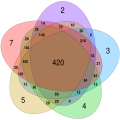Least common multiple
The least common multiple of two integers is the smallest positive integer between all the multiples of both. It is usually written as LCM(a, b).[1] Likewise, the LCM of more than two integers is the smallest positive integer that is divisible by each of them.[2][3]
Overview
Elementary arithmetic
In elementary arithmetic, the LCM is also the "lowest common denominator" (LCD) that must be calculated, before fractions can be added, subtracted or compared.
A multiple of a number is the product of that number and an integer. For example, 10 is a multiple of 5 because 5 × 2 = 10, so 10 is divisible by 5 and 2. Because 10 is the smallest positive integer that is divisible by both 5 and 2, it is the least common multiple of 5 and 2. By the same principle, 10 is the least common multiple of 5 and 2 as well.
Relations with the greatest common divisor
It is known that:
- [math]\displaystyle{ \operatorname{GCD}(a,b) \cdot \operatorname{LCM}(a,b) = |a \cdot b| }[/math]
where [math]\displaystyle{ \operatorname{GCD}(a,b) }[/math] is the greatest common divisor of a and b, This formula is often used to compute the LCD, by first finding the GCD of a and b.
Least Common Multiple Media
A Venn diagram showing the least common multiples of all subsets of {2, 3, 4, 5, 7}.
Related pages
References
- ↑ "Comprehensive List of Algebra Symbols". Math Vault. 2020-03-25. Retrieved 2020-08-30.
- ↑ Weisstein, Eric W. "Least Common Multiple". mathworld.wolfram.com. Retrieved 2020-08-30.
- ↑ "Least Common Multiple". www.mathsisfun.com. Retrieved 2020-08-30.

